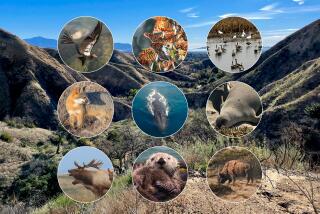High Island beckons bird watchers
- Share via
Reporting from High Island, Texas — As my airliner approached George Bush Intercontinental Airport in Houston, the pilot declared the weather in southeastern Texas sunny, warm and mild.
Great, I thought, blue skies and gentle breezes. Just my luck.
My final destination was High Island, about 80 miles southeast of Houston on the Gulf Coast.
This mound of trees and shrubs, only a mile in diameter, has a reputation as one of the country’s top birding sites. As an occasional bird watcher, I was drawn here by this reputation. But I was rooting for a storm because, according to bird aficionados, the best bird watching on High Island takes place during, or just after, a storm front with strong northerly winds. Migrating birds -- warblers, orioles, thrushes and others -- struggle against the gusts as they fly north from the Yucatán Peninsula, 600 miles across the Gulf of Mexico.
When the exhausted birds reach the shore and spy the hospitable habitat, they sometimes fall from the sky. High Island is geographically suited for this phenomenon -- known as a fallout. From the air, High Island looks like a protrusion of trees, surrounded by flat, salty marshlands, an ideal resting spot for migrant birds.
After a storm, the wind-battered birds are so exhausted by the trans-gulf flight that they become almost oblivious to bird watchers. Enthusiasts who have seen a fallout told me that you can almost pick up and pet the exhausted birds. I felt guilty for wishing such conditions on these innocent creatures. But it’s a centuries-old natural event, so why not take advantage of an opportunity to see some rare neotropical birds up close?
My visit to High Island in early March, however, taught me that Texas’ unpredictable weather makes it difficult to plan to see a fallout.
Still, the abundance of wildlife here -- from gorgeous pink spoonbills to toothy alligators -- makes the trip worthwhile, even without a fallout. And even more surprising, I learned that the fury unleashed on the surrounding coastline six months ago by Hurricane Ike made this sanctuary only more inviting to native and transient creatures.
::
Technically speaking, High Island is neither an island nor high.
It rises about 30 feet above the nearby marshes and is surrounded by water only after a storm surge. The town of High Island, with a tuft of oaks, mulberry, cypress and hackberry trees, sits atop a salt dome that has pushed the soil up from thousands of feet below the surface.
Fewer than 500 Texans call High Island home, but at the height of migration season -- early March through mid-May -- thousands of birds rest and feed here before setting off to the Midwest and the eastern United States, although some fly as far as Alaska.
Packing a pair of binoculars, a digital camera and a field guide to North American birds, I drove to the Louis B. Smith Bird Sanctuary, a 45-acre patch of woods surrounded by quiet residential neighborhoods. (It’s also known as Boy Scout Woods, because it was home to a Scout camp decades ago.) The Houston chapter of the Audubon Society owns four sanctuaries on the island, and the Texas Ornithological Society owns a fifth refuge.
Near the entrance, I met Andrew Beck, an Audubon sanctuary steward who agreed to give me a tour of the island. The 28-year-old doesn’t fit the stereotype of a birder, a hobby that has become increasingly popular among baby boomers and retirees. Beck’s father and uncle encouraged his love for birding, which started when he was a boy, he explained as he led me around the sanctuary’s narrow trails.
It had been six months since Ike, a Category 2 hurricane, tore into the Texas coast, and the sanctuary was still a tangle of upturned trees, broken branches and snarled underbrush. Beck’s job is to clear the trails and pull out the aggressive nonnative plants, such as Chinese privets, that can dominate the vegetation and replace berry-producing trees that feed birds year round.
That was but one of several side effects of the storm. After Ike wiped out habitat and fresh water sources along much of the coast, Beck said the remaining trees and freshwater ponds on High Island became even more attractive to alligators, snakes, armadillos and, most important, birds. Audubon officials have conducted no surveys to confirm this claim but have counted, for example, more than twice the number of alligators -- 30-plus -- than at any time in the past.
As Beck explained this, his attention was drawn to the treetops by the tweet, tweet, tweeting of a yellow-crowned warbler. “Each week we will be seeing more and more until mid- to late May,” he said.
In the Boy Scout Woods, we walked along the dirt trails, stopping at several wood benches and small grandstands strategically located in front of small fountains and ponds where birds splashed and sipped water.
From a distance, the colorful migrants looked like bright, cellophane-wrapped candies among the branches: A yellow-rumped warbler, a candy-apple-red cardinal, a caramel brown Carolina wren. The air pulsated with chirps and twitters.
It’s no wonder the island draws up to 10,000 visitors a year. At the height of the spring migration, 600 to 1,000 birders swarm the sanctuaries, pointing binoculars and spotting scopes at the feathered inhabitants.
It was all very lovely, but I’m a fan of the big birds: hawks, herons, eagles and vultures. It’s probably a guy thing.
High Island had me covered. Beck led me to its largest refuge, Smith Oaks Bird Sanctuary, 145 acres of woods, fields, wetlands and ponds. (Only a few blocks separate the Smith Oaks Bird Sanctuary and Boy Scout Woods.)
From a dirt parking lot at Smith Oaks, we hiked to the banks of man-made Clay Bottom Pond, which was once used to store the town’s water supply. Today the pond is the sanctuary’s watery hub. A narrow dirt path circles the pond, and several benches and viewing platforms line the trail.
(Just a note for hikers/walkers: There are portable bathrooms but no drinking water at the Smith Oaks Bird Sanctuary. Also, mosquitoes, poison oak and snakes are abundant here. More amenities, including bathrooms and information kiosks, are available at the Boy Scout Woods sanctuary.)
You don’t have to be a bird lover to be awed by the views from the shores of Clay Bottom Pond.
At its northern end, egrets, herons and cormorants were building nests atop oak and cypress trees on a U-shaped island known as the Rookery. On the southern end, blue-winged teals and roseate spoonbills waded in the shallows looking for shrimp, fish and other munchies on the wide, muddy banks of Heron Island, which is really an islet. (The spoonbills get their pink color from eating shrimp. The older the spoonbill, the richer the pink.)
To my surprise, the waters in the pond rippled with alligators, some juveniles only 4 or 5 feet long. But the adult alligators, gnarled and fierce-looking, were as long as canoes. The alligator-infested waters surrounding the Rookery protect the nesting birds from raccoons, coyotes and other egg-snatching predators. Later, I witnessed a gator -- about 12 to 15 feet long -- make a meal of a football-size turtle, cracking the shell with a loud snap.
As Beck and I approached the water’s edge, we triggered a panic.
The spoonbills, as pink as cotton candy, took wing. Snow white egrets, lanky and graceful, also launched from the surface. Black cormorants and teals followed. The sky was a kaleidoscope of color and movement.
“Don’t worry,” Beck said. “They’ll come back.”
And they did. We sat quietly for several minutes and watched as the birds circled the pond and returned to their original spots in the water and on the trees.
Once the birds settled back on their perches, they returned to their previous conversations. The black cormorants croaked, the teals quacked and the grackles -- a black bird with a long keel-shaped tail -- let loose a series of amplified cracks, clacks and snaps.
The spring migration was just beginning, but the trees were already bursting with sound.
I asked Beck what it’s like at the height of the season.
“Loud,” he said.
Hiking out of the sanctuary, we met Winnie Burkett, the longtime sanctuary manager, who was sitting on a truck bed having lunch with another Audubon staffer.
She has mixed feelings about the fallout. Many of the migrant birds that cross the gulf arrive on the island nearly drained, Burkett said. Some birds die in the attempt and wash up on the beach.
But for those birds that make the crossing, she is happy to manage a place that serves as a refueling stop for more than 300 species.
“Given the opportunity, the natural world is pretty resilient,” she said.
I left High Island for a few hours to check out the shorebirds near Crystal Beach, a nearby community that was all but wiped out by the hurricane. The sky darkened and a light shower streaked my windshield.
A storm was moving in. Maybe the conditions were right for a fallout, I thought.
I returned to Smith Oaks as the sun was beginning to set.
By the time I reached the western shore of Clay Bottom Pond, the rain had subsided, the clouds had parted and bright rays of sun shone through.
It seemed as though I wouldn’t see a fallout during this visit, but High Island offered me a scene from the water’s edge that more than made up for it.
Dozens of spoonbills, egrets and cormorants were perched in the branches of a stand of cypress and oak trees on the opposite shore, like ornaments on a row of Christmas trees.
As I watched, a full rainbow materialized directly over the ornamented trees.
It was a glorious visual souvenir. And High Island even wrapped it up in a bow.
latimes.com /texasbirds Island visions Head online to see more images of High Island and its wild inhabitants.
More to Read
Sign up for The Wild
We’ll help you find the best places to hike, bike and run, as well as the perfect silent spots for meditation and yoga.
You may occasionally receive promotional content from the Los Angeles Times.






